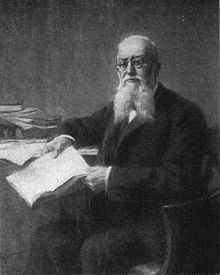Johannes Kaempf
Johannes Kaempf (born February 18, 1842 in Neuruppin ; † May 25, 1918 in Berlin ) was a German free-thinking politician and banker . From 1912 to 1918 he was President of the Reichstag.
Life
Johannes Kaempf was director of the branch of the bank for trade and industry in Berlin and president of the German Trade Conference . As President of the National Economic Society in 1903 he advocated the establishment of a Berlin School of Commerce . He was a member of the Free People's Party and the Progressive People's Party and represented the first Berlin constituency in the Reichstag for the left-wing liberals from 1903 to 1918 . From 1912 until his death he was President of the Reichstag .
On October 22, 1899, Kaempf was awarded the honorary title of City Elder of Berlin . In 1915 he was awarded an honorary title by Kaiser Wilhelm II . The reason for this was the resolution for the inscription " Dem Deutschen Volke " on the Reichstag building in Berlin.
Kaempf was a member of the Masonic lodge Sankt Johannes zum Schwarzen Adler in Landsberg an der Warthe and an honorary member of the Great National Mother Lodge to the three globes .
Johannes Kaempf died in Berlin in May 1918 at the age of 76 and was buried in the Old St. Matthew Cemetery in Schöneberg . In the course of the leveling of the cemetery carried out by the National Socialists in 1938/1939, Kaempf's remains were reburied in the south-west cemetery in Stahnsdorf near Berlin, where his grave has been preserved.
Kaempf's death had an unexpected side effect on the fate of the empire. Because of the need to fill Kaempf's Reichstag mandate in constituency I, the USPD was able to nominate the left-wing trade unionist and revolutionary Richard Müller for the by-election; the government had to exempt him from military service. Müller was released from the army in September 1918 and came to Berlin, lost the by-election, but played a significant role in organizing the November 9 uprising.
Fonts
- Johannes Kaempf: speeches and essays. Published by the elders of the Berlin merchants. Berlin, Georg Reimer 1912.
literature
- Wolfgang Wölk: Kaempf, Johannes. In: New German Biography (NDB). Volume 10, Duncker & Humblot, Berlin 1974, ISBN 3-428-00191-5 , p. 728 f. ( Digitized version ).
Web links
- Johannes Kaempf in the database of members of the Reichstag
- Biography of Johannes Kaempf . In: Heinrich Best : database of the members of the Reichstag of the Empire 1867/71 to 1918 (Biorab - Kaiserreich)
- Newspaper article about Johannes Kaempf in the press kit of the 20th century of the ZBW - Leibniz Information Center for Economics .
Individual evidence
- ^ Hans-Jürgen Mende: Lexicon of Berlin tombs . Haude & Spener, Berlin 2006. pp. 304, 471.
- ↑ Ralf Hoffrogge : Richard Müller - The man behind the November revolution. Berlin 2008, p. 60 ff.
| personal data | |
|---|---|
| SURNAME | Kaempf, Johannes |
| BRIEF DESCRIPTION | German politician (FVP, FVp), MdR and banker |
| DATE OF BIRTH | February 18, 1842 |
| PLACE OF BIRTH | Neuruppin |
| DATE OF DEATH | May 25, 1918 |
| Place of death | Berlin |
